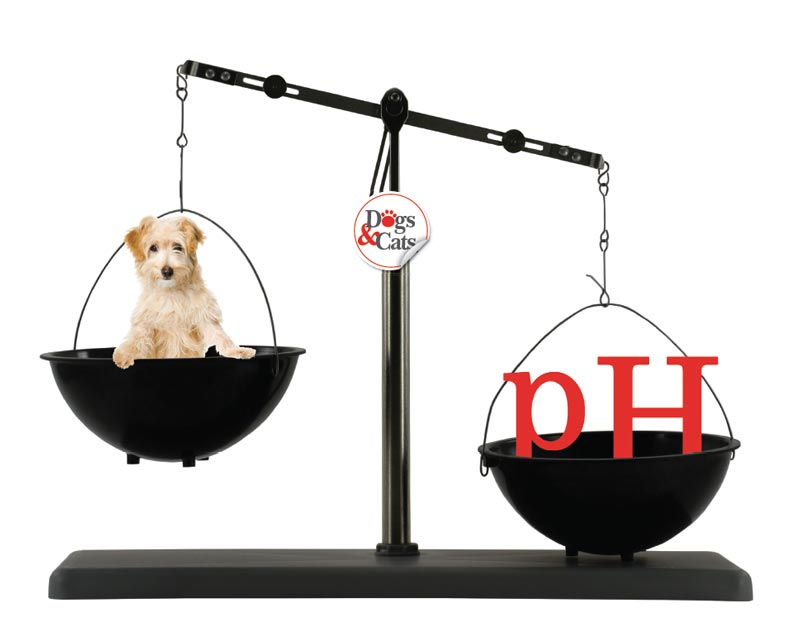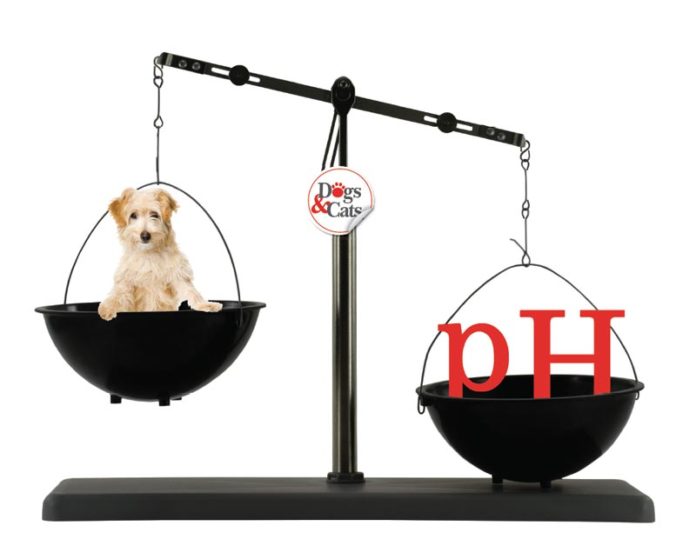A pH imbalance can impact his health and well-being, and is associated with a variety of health condition.
When your dog or cat is under the weather, the first thing you do is take him to the vet for a checkup. Whatever his symptoms, there are many potential causes, so it’s always important to get a professional assessment. One of the things you might not take into consideration when trying to determine what’s wrong with your furry friend is his pH levels. Several common diseases that occur in animals can be associated with a pH imbalance. Areas of the body that may be affected include the digestive and urinary systems, as well as the blood.
Red flags to watch for
A pH imbalance can generate a range of symptoms. Digestive signs can include diarrhea, vomiting, itchy skin and anus, yeast infections and bad breath. Animals with urinary pH imbalance may experience increased thirst and frequency of urination, an urgency to urinate, hematuria (bloody urine) or inappropriate urination. Hematological pH issues are usually caused by metabolic disease; common symptoms include chronic vomiting, diarrhea, weight loss, dull coat, dehydration and lethargy. Of course, these symptoms can have many different causes, but know that a pH imbalance can sometimes be involved.
1. Digestive imbalance
The most common illnesses associated with gastric pH imbalance include dysbiosis (leaky gut), systemic yeast infections, or other chronic infections, food intolerances, and irritable bowel-like symptoms.
Healthy digestive pH: 1-2 during digestion and 4-5 when resting.
Testing: The above signs and symptoms are the best way to determine if there is a pH imbalance in the gut, along with an investigation into any other pH imbalances in the body.
2. Urine imbalance
A urine pH imbalance is a common cause of urinary dysfunction, including infections and urolithasis (crystals or stones).
Healthy urine pH: Approximately 6.2 to 6.5.
Testing: A urinalysis can be done at your vet’s office to determine the animal’s urine pH.
 3. Blood imbalance
3. Blood imbalance
A pH imbalance of the blood often occurs with underlying metabolic diseases. The most common are acidosis caused by renal failure, and ketoacidosis caused by unregulated diabetes. Other causes include overzealous use of corticosteroids, poisoning and urinary blockages (urolithathis).
Healthy blood pH: Just over 7.
Testing: This can be done at your vet’s office to determine the state of your animal’s glandular function, urine pH and blood pH.
Diseases associated with PH imbalance
Urinary tract infections, crystals and stones (urolithasis) – Infections of the urinary tract are usually caused by bacteria such as e coli, staphylcoccus, streptococcus and proteus. These bacteria can thrive if urine pH is not correct. Infections cause the smooth muscle linings of the urethra and bladder to become inflamed and weakened, and can cause permanent damage if left unattended. Chronic infections are particularly common with urinary pH imbalance.
Crystals in the urine can occur for several reasons, in any part of the urinary system. Commonly occurring crystals include struvite, cysteine, oxalate and urate. Some are caused by low urine pH, others by high urine pH. A urinalysis will determine the exact mineral formation of the crystals or stones. When uroliths grow to macroscopic sizes, they can interfere with the flow of urine from the kidneys to the bladder and from the bladder to the urethra. This can cause irritation and inflammation of the mucosal membranes and may lead to stranguria (slow and painful urination), dysuria (pain), hematuria and acidosis (blood acidity).
Renal disease: Kidney disease generally takes years to develop and has devastating effects, including blood acidosis. Proper hydration, high quality protein sources, and low dietary phosphorus are keys for maintaining animals suffering from kidney dysfunction. Additional treatment will vary greatly based on the animal’s state of renal function, age, breed and diet.
Diabetes: Unregulated diabetes causes a condition called ketoacidosis, which can be determined by blood test. Correcting and stabilizing blood glucose levels is essential to reducing the risks associated with ketoacidosis, which include increased thirst/urination, lethargy, increased or decreased appetite, vomiting and weight loss.
Yeast infections and dysbiosis: Yeast infections of the gut and other digestive illnesses are often associated with dysbiosis (leaky gut syndrome), a condition of the intestinal tissue in which holes form in the digestive lining, causing an increased risk of bacterial infection and other digestiverelated illness.
Whatever your dog or cat’s health issue, balancing his pH levels can help him. Switching him to an appropriate diet and adding some specific balancing supplements (see sidebar) are important ways to get his pH back on an even keel.
Sarah Griffiths, DCH, CPN, is a classical homeopath and clinical animal nutritionist with an extensive background in the husbandry of wild canines and felines. She consults with local veterinarians and for 3P Naturals, a raw pet food company in Vancouver. Sarah runs free raw pet food education seminars in the Lower Mainland of British Columbia, and helps people with raw diet planning, troubleshooting and individual supplementation.

